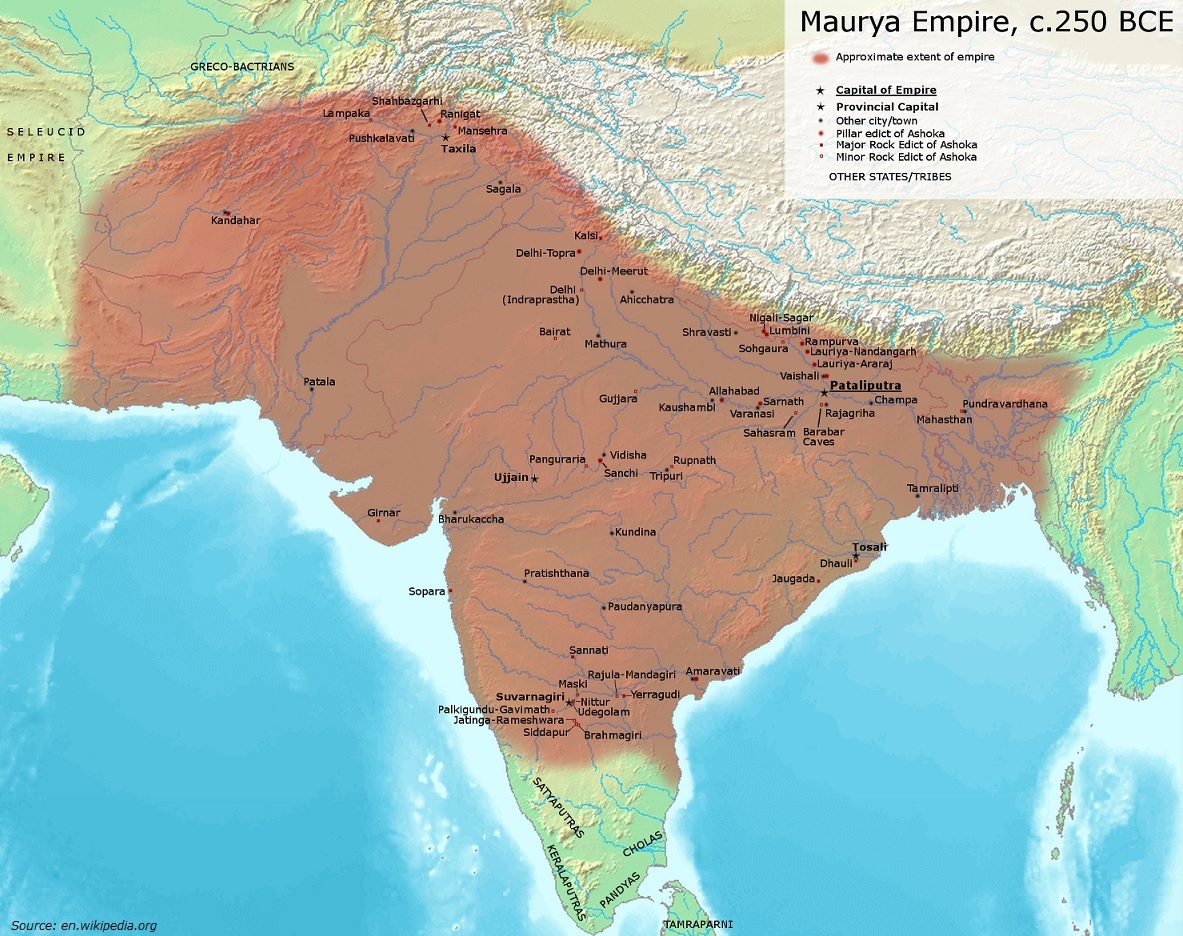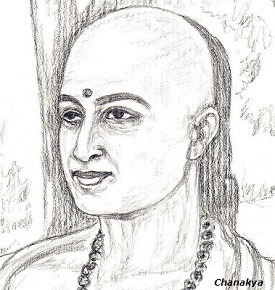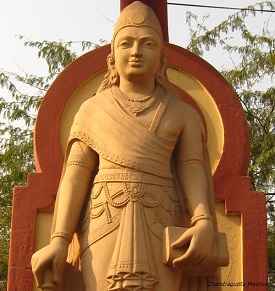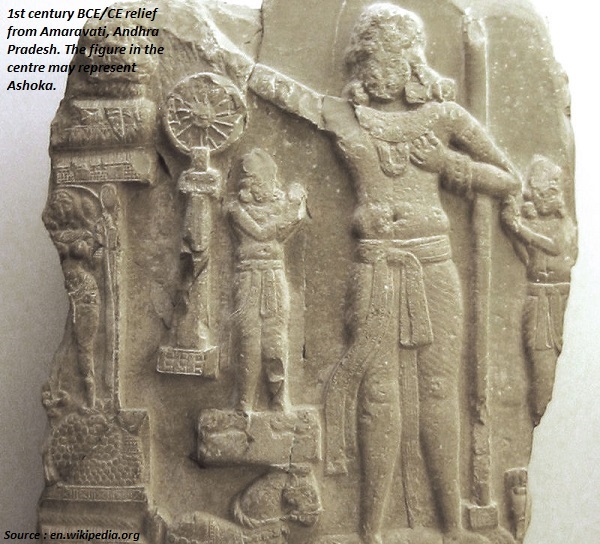
- Ancient Indian History - Home
- Study of Indian History
- Writing of Ancient Indian History
- Imperialist Historiography
- Historiography Nationalist Approach
- Marxist School of History
- Sources of Ancient Indian History
- Archaeological Sources
- Geographical Background
- Geography in Ancient Literature
- Stone Age Cultures
- Mesolithic Culture
- The Neolithic Age
- Chalcolithic Period of India
- Chalcolithic Culture In India
- Harappan Civilization
- Harappan Town Planning
- Harappan Crafts & Industries
- Harappan Culture
- Harappan Religion
- Harappan Chronology
- Vedic Civilization
- Vedic Society
- Vedic Politics
- Vedic Religion & Philosophy
- The Aryan Invasion
- Later Vedic Age
- Social System after Vedic Age
- Achievements of Indian Philosophy
- Evolution of Jainism
- Evolution of Buddhism
- Alexander’s Campaign in India
- Maurya Dynasty
- Kalinga War & its Impact
- Society & Economy during Mauryas
- Mauryan Governance
- Early History of South India
- Age of Smaller Dynasties
- Literature of Satavahana Period
- Society of Satavahana Period
- Economy of Satavahana Period
- Technology of Satavahana Period
- Chola Dynasty
- Pandya Dynasty
- Chera Dynasty
- Period of Foreign Invaders
- Gupta Period
- Decline of Guptas
- Governance of Gupta Period
- Literature of Gupta Period
- Economy in Gupta Period
- Science & Tech of Gupta Period
- India after the Gupta Period
- Period of Harsha
- South India during the Harsha Period
- Kadamba Dynasty
- History of Kamarupa
- India after Harsha
- Gurjara Pratiharas
- Palas of Bengal
- Rashtrakutas of Deccan
- Literature after the Harsha Period
- Society after the Harsha Period
- Economy after the Harsha Period
- Religion after the Harsha Period
- References & Disclaimer
Ancient Indian History - Maurya Dynasty

The Mauryan Empire was the first largest empires that ever established on Indian soil till 324 B.C.
The epigraphical sources, literary sources, foreign accounts, and other materials obtained from the archaeological excavations describe the greatness of the Mauryan rulers and vast extensions of their empire.
The Mauryan Empire was spread from the valley of the Oxus (present Amu River) to the delta of Kaveri.
Chandragupta Maurya was the first ruler who unified entire India under one political unit.

The detailed information about the administrative system of the Mauryan Empire is mentioned in Arthashastra. It is a book written by Kautilya. He was also known as Chanakya.
Kautilya was the Prime Minister of Chandragupta Maurya. He was considered as the real architect of the Mauryan Empire.
Megasthenese came in the court of Chandragupta Maurya as an ambassador of the Seleucus (the king of Greek).
Megasthenese has given detailed accounts of India and Indian people in his book Indica. Though the original book is lost; however, historians extracted Megastheneses description through the quotations in the works of the later Greek writers.
The inscriptions of the great Ashoka are the most important and authentic source for the history of Mauryan period.
Chandragupta Maurya

Chandragupta Maurya had ruled during the period of 324-300 B.C.
The Buddhist literature, the Mahavamsa and Dipavamsa give a detail account of Chandragupta Maurya.
Chandragupta Maurya has been described as a descendant of the Kshatriya clan of the Moriyas branch of Sakyas. They lived in Pipphalivana, in eastern Uttar Pradesh.
The Mudrarakshasa is a play written by Vishakhadatta, referred Chandragupta as Vrishala and Kulahina, which means a person of humble origin.
According to Buddhist Traditions
Chandragupta's father was killed in a battle and he was brought up by his maternal uncle.
Chanakya observed the signs of royalty in the child Chandragupta and took him as his pupil. He took him at Taxila for his education and training. Taxila, at that time, was a great center of learning.
The Greek sources described that while he was in Taxila, Chandragupta had seen Alexander in a course of the Punjab campaign. However, the reliable details of Chandragupta's conquests and empire building process are not available.
According to Greek and Jain Sources
Chandragupta took advantage of the disturbances caused by the invasion of Alexander and his sudden death in 323 B.C. in Babylon.
With the help of Kautilya, Chandragupta raised a large army and launched campaigns. He first overthrew the Greek kshatrapas ruling in the region of north-western India.
Greek writer Justin, writes, "India after the death of Alexander, had shaken, as it were, the yoke of servitude from its neck and put his Governors to death, and the architect of this liberation was Sandrocottas.
The Sandrocottas mentioned in the Greek literature has been identified with Chandragupta Maurya.
After liberating north-western India from the Greek rule, Chandragupta turned his attention towards the conquest of Magadha (where Nanda was the Emperor). However, the details of this conquest are not known.
According to Parisistha-parvam (the Jain text), Chandragupta with the help of Chanakya, defeated the Nanda king and captured his empire and became the great ruler of Magadha empire.
Ashoka and his father Bindusara (son of Chandraguptha Maurya) did not make any conquest in south India. Therefore, it was Chandragupta Maurya who made it.
The Junagarh rock inscription describes that a dam for irrigation was constructed on the Sudarshana Lake by Pushyagupta, a provincial governor of Chandragupta Maurya.
Inscriptions of Ashoka found at Girnar hills in Junagarh district in Gujarat and at Sopara, in Thane district in Maharashtra reflect that these areas were under the rule of Mauryan Empire.
In south India, Ashoka's inscriptions have been found at Maski, Yerragudi, and Chitaldurga in Karnataka.
Rock Edict II and XIII of Ashoka explain that Chandraguptas immediate neighboring states (in the south) were Cholas, Pandyas, Satyaputras, and Keralaputras.
The Jain tradition confirms that in his old age, Chandragupta abdicated the throne and retired to Shravanabelagola in Karnataka with his teacher Bhadrabahu (a Jain ascetic).
Local inscriptions of the later period mentioned that Chandragupta gave up his life as a Jaina devotee by fast unto death at a hill, which later on called as Chandragiri, seems to be named after him.
In about 305 B.C. Chandragupta defeated the army of the Greek Kshatrapa Seleucus who had succeeded Alexander in the eastern part of his empire.
The Greek writers stated that a treaty was concluded between Seleucus and Chandragupta in which Seleucus accepted the territories of Kandahar, Kabul, Herat, and Baluchistan and Chandragupta presented him 500 elephants.
The treaty was followed by a matrimonial alliance between the two in which Seleucus married his daughter to Chandragupta Maurya or to his son Bindusara.
Seleucus sent Megasthenese as his ambassador to the court of Chandragupta.
Plutarch writes, "Sandrocottas who had by that time mounted the throne overran and subdued the whole of India with an army of 600,000".
It is clear that Chandragupta had established a vast empire extended from Afghanistan in the west to Assam in the east and from Kashmir in the north to Karnataka in the south. The entire country except Kalinga was under his rule.
Bindusara (son of Chandragupta), did not make any conquests. Thereafter, Ashoka (son of Bindusara) is said to have added only Kalinga to the Mauryan-empire.
Chandragupta Maurya had ruled for 24 years i.e. from 324 B.C. to 300 B.C.
Bindusara (300-273 B.C.)
Bindusara, the son of Chandragupta Maurya, ascend to throne after his father.
According to the Tibetan historian, Taranath, Chanakya continued as a minister of Bindusara after Chandragupta Maurya. Hemachandra, Jain scholar, also confirms this fact.
Divyavadana mentions that Bindusara appointed his eldest son Sumana (or Susima) as his viceroy at Taxila and Ashoka at Ujjain. It also mentions that when a revolt broke out at Taxila, Ashoka was sent to restore peace as Susima fails to suppress it.
Bindusara continued his policy of friendly relations with Hellenic world.
Dionysius was the Egypt ambassador came to the court of Bindusara.
Pliny mentions that Ptolemy Philadelphus, king of Egypt sent him as an ambassador.
Bindusara had been given the credit of south Indian conquest, but most of the scholars believe that this was done by his father Chandragupta Maurya.
Ashoka (273-232 B.C.)
Ashoka succeeded to the throne after the death of his father Bindusara in 273 B.C.
-
According to the Buddhist tradition,
Janapada Kalyani or Subhadrangi was his mother.
He was appointed as a viceroy of Ujjain and Taxila while he was a prince.
Ashoka was very cruel in his early life and captured the throne after killing his 99 brothers. But it appears an exaggerated figure.

Ashoka himself speaks affectionately about his brothers, sisters, and relatives in his edicts.
Ashoka was the first king in the Indian history who has left his records engraved on stones.
The history of Ashokas reign can be reconstructed with the help of his inscriptions and some other literary sources.
The Ashokan inscriptions are found at 47 places in different regions of India, Nepal, Pakistan, and Afghanistan.
The inscriptions on rocks are called as the Rock Edicts, and those on Pillars, Pillar Edicts.
Ashokas name occurs only in copies of Minor Rock Edict-I found at three places in Karnataka and one in Madhya Pradesh. Whereas in all other inscriptions, he mentioned himself as Devanampiya and Piyadasi meaning beloved of the gods.
-
Ashoka s inscriptions were written in four different scripts, namely −
Greek languages and scripts used in Afghanistan area;
Aramaic languages and scripts used in west Asia;
Prakrit language and Kharosthi script used in Pakistan area; and
Prakrit language and Brahmi script used in rest of the inscriptions.